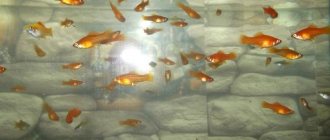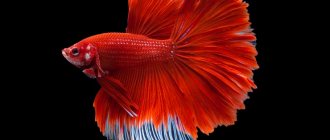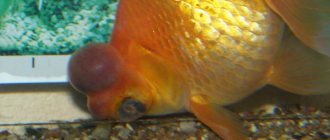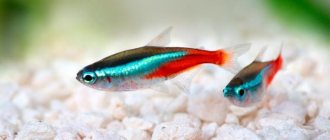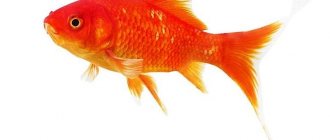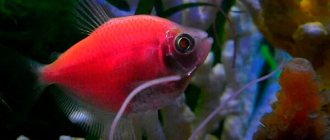Red glossolepis (Glossolepis incisus) Weber, 1908.
The species of rainbow fish, discovered in 1907/8, appeared among domestic aquarists only in the late 1970s.
Synonyms
Russian: Red smelter, New Guinea rainbowfish, Red rainbowfish, Crested rainbowfish, Red rainbowfish
Family: Rainbows (Melanotaeniidae) Genus: Glossolepis
Range and Habitat
Asia: Lake Sentani in Irian Jaya, Indonesia.
It is endemic to Lake Sentani and its tributaries in northern New Guinea. The lake is connected to the Pacific Ocean by the Tami and Jafuri rivers and therefore contains an interesting mix of species.
Typically found near the coastline, in shallow waters with rich vegetation. The bottom is made of sand, pebbles and stones with fallen tree branches.
At home
Under natural conditions, fish live in brackish water in coastal sea zones and in river mouths. Distributed in various parts of the world: in the tropical waters of the Indian, Atlantic and Pacific oceans and associated seas.
The fish lead a gregarious lifestyle, staying in large groups. They feed on animal food, but are not active predators. They reproduce by laying eggs on the leaves of aquatic plants. Some species return to fresh waters for the purpose of spawning.
Among the Atherinaceae there are aquarium and commercial fish.
Description
The body shape is elongated, flattened on the sides. Males have a sharply arched dorsal line. Fish, like all irises, are characterized by thick lips and large eyes. The tail is forked. The dorsal fin is formed by a short front part and an elongated second part shifted towards the tail. The anal fin is long.
Males are distinguished by a deep red color with a silver sheen, the brightness of which depends on the conditions of detention. On their sides there are transverse stripes of burgundy color. The females do not look so impressive and are colored greenish or yellowish, turning into olive on the back.
Small thin transverse stripes are randomly scattered throughout the body. Males have red fins, females have transparent ones. The fish also differ in the color of the iris, which is golden in females and red in males.
Size:
Males grow up to 15 cm, the length of females does not exceed 10 cm.
Fish diseases
Health problems arise only in case of injury or when kept in inappropriate conditions, which suppresses the immune system and, as a result, provokes the occurrence of any disease. If the first symptoms appear, it is first necessary to check the water for excess of certain indicators or the presence of dangerous concentrations of toxic substances (nitrites, nitrates, ammonium, etc.). If deviations are detected, bring all values back to normal and only then begin treatment. Read more about symptoms and treatment methods in the section “Diseases of aquarium fish”.
Behavior and Compatibility
They are gregarious and should ideally be kept in groups of 5 or more individuals, with approximately equal numbers of males and females.
They are very active and have a peaceful nature, but can disturb smaller or slower-moving fish with their fast movements and relatively large size. Ideal neighbors would be other similarly sized irises, zebrafish, barbs, catfish - such as corydoras.
Glossolepis red
Family: Melanotheniaceae.
Habitat: Australia, New Guinea. Water temperature: 23-27. Acidity: 7.0-8.0. Hardness: 8-20.
Glossolepis red
Glossolepis red has an ellipsoidal body, tall, elongated and flattened on the sides. Big eyes, thick lips. The tail fin is two-lobed. The coloring of young and adult fish is significantly different. Young fish are silver in color. Males may change body color from silver to black if the lights in the aquarium are turned off for a while and then turned on again.
Adult males are colored red, individual scales have a pearlescent sheen. On the sides there are fuzzy burgundy transverse stripes. The iris of the eye is red. The dominant male has a darker and more saturated color. Adult females are yellowish-green in color with an olive back. There are many short and thin transverse stripes scattered on the body. The iris of the female eye is golden. The fins are transparent. Under natural conditions, red atherine grows up to 15 cm in length. Life expectancy in captivity is 5-8 years. It stays in the middle layer of water.
Glossolepis red
It is best kept in a species aquarium with a lid on top (the fish jump out when scared), at least 80 cm long with thickets of plants, various shelters and free space for swimming. Water parameters: hardness 10-25, pH 6.8-8, temperature 22-26 C. Filtration, aeration and weekly replacement of up to 30% of the water volume are required.
Glossolepis red
The aquarium should not contain excessive concentrations of nitrogen compounds and phosphates. Every conscientious aquarist should always have a set of drop tests on hand, at least for nitrate and phosphate. Fortunately, they have now become inexpensive, there are no problems with their assortment and acquisition. For example, we can in good conscience recommend you the cool UHE drop tests that have been tested on ourselves, but they are only sold online. In stores in your city - offline, you can find inexpensive Vladox tests.
When changing water, it would be useful to use clean water supply and use preparations that neutralize harmful substances. For example, Tetra AquaSafe - it removes chlorine compounds, heavy metals + contains B vitamins, iodine and other aquarium goodies.
Glossolepis red
Feeding aquarium fish should be correct: balanced, varied. This fundamental rule is the key to successfully keeping any fish. For glossolepis iris, TetraMin food is perfect as a base, and since the fish have a rich red color, you can additionally use food with carotenoids, which enhance the color of the fish. For example, food from the Tetra Ruby or Tetra Color series are perfect.
Breeding/Spawning: Sexual maturity is reached at 12-16 months of age. For spawning, a couple of fish are placed in a separate aquarium with a large number of plants. Before this, producers must receive a variety of food, including live food. The eggs are laid in portions. Spawning lasts several days. The laid eggs must be removed immediately after spawning. To successfully raise fry at the first stage, small feed will be required. They practice feeding with ciliates or “bloomed” water, which contains a lot of unicellular algae, which the fry feed on. At first, the fry grow very slowly and are demanding of food and water quality.
It should be noted that glossolepis and other irises in aquarium conditions can produce hybrid offspring. To preserve the purity of species, it is necessary to prevent such cases
Video of red glossolepis
+
Aquarium
For a small group you will need an aquarium with a minimum size of 100 cm and a volume of 100, and preferably 200-300 liters and always with a lid, since they can jump out if frightened.
The plants are not damaged and there are no restrictions on their choice, but it is desirable that they be species with rich green leaves, then the color of the fish will benefit from their background. Vegetation should be planted around the perimeter, leaving free space for swimming.
Decorations include stones, branchy driftwood and decorative grottoes. The main thing is not to overload the aquarium with them, as this is a spectacular iris in itself and an excess of decorations will be distracting.
Water parameters:
Temperature: withstands fluctuations within 22 - 30° C pH: 7.0 - 8.2 Hardness: 10 - 20° dGH
Filtration with aeration is required. The movement of water should be quite gentle. Frequently changing a quarter of the water will have a positive effect on the well-being and beauty of these fish.
Content
These fish are a real gift for lovers of African cichlids. Their bright colors will undoubtedly add variety to the color scheme of any aquarium.
The decorative effect of these fish is really great, but it is not only worth noting. These fish have an amazing calmness and confidence, which in turn inspires confidence in even the most timid cichlids.
These fish are quite maneuverable and have excellent speed, which allows them to nullify any claims of other territorial aggressors. They do not climb into the cichlids' hiding places, which also does not disturb the peace in the aquarium. Glossolepis even does not touch plants, and you can plant any type of greenery with them.
Video. Glossolepis in the aquarium:
Breeding
Capable of spawning in general and in a separate aquarium. The second option is preferable. Small-leaved plants, for example, Java moss, which will serve as a substrate, are placed in an elongated spawning tank with a volume of 70 liters or more. You can replace it with a nylon washcloth. Soil is not needed, but it is necessary to install a filter (possibly an air filter) to enrich the water with oxygen and create a slight flow.
Water parameters in the spawning tank: 23-26°C, pH 7.5, dH 18-25.
A pair or two females and four males are pre-planted in separate containers for 1-2 weeks. During this period, producers should eat plentifully and variedly.
A slight increase in temperature can trigger spawning.
Usually red rainbowfish spawn for several days, but sometimes the process lasts for several weeks. Every day, the female spawns several transparent and sticky eggs about 1 mm in size, which first float freely in the water and then become attached to the substrate. The productivity of a female is a maximum of 700 eggs.
To prevent the parents from eating the eggs, they need to be fed very generously, but it is better to periodically move the eggs into a separate container with water from the spawning aquarium, and add new moss to the spawning tank.
Incubation of eggs lasts approximately 7-8 days. The hatched fry first float to the surface for a breath of air, and then immediately need food. Juveniles take live dust, Cyclops nauplii, ciliates and rotifers. After a week or so, the brine shrimp nauplii begin to appear. The fry grow very slowly and in the initial stages are especially sensitive to water quality.
Life expectancy is about 10 years.
Feeding
The conditions for feeding juveniles, keeping and breeding fish of this species are the same as for other representatives of the family. Having passed the age of one month, the fry begin to grow much faster. Juveniles must be well fed to avoid cannibalism. Poor water quality, as well as its pollution, is the main cause of death of juveniles. The fry's water needs to be changed as often as possible, preventing the decomposition of food and the accumulation of waste products. There is another problem here - with filters. Often juveniles are simply sucked in there.
To ensure that the red color of the fish is as intense as possible, it is recommended to offer them fortified food rich in carotenoids. “Tetra-Ruby”, “Extra-Purple” and others are suitable, which need to be periodically added to the fish’s diet from an early age. You can feed the fish live or frozen brine shrimp and cyclops, which gives the same effect.
There are other, not so popular and smaller species of glossolepis. You can find the bluish Wanamensis (Glossolepis wanamensis Alien & Kailola, 1979), which is bred by some collectors. These fish were caught in Lake Ouanam in New Guinea, which is where they got their name.
Other names: Red smelt, Iris crest
Glossolepis flock
Red glossolepis (Glossolepis incisus) A couple of glossolepis
Notes
This species is one of the most popular rainbow fish in aquariums. Unfortunately, the coloration of modern mass-breeding specimens is not even close to the coloration of wild fish.
Juveniles appear inconspicuous, having an overall olive-greenish color with a slightly noticeable silvery sheen. However, once they reach a length of 4 to 5 cm, the males begin to show color. Once the color change begins to occur, it progresses quite quickly. By the time the fish reaches 7 to 8 cm in length, the males have acquired a full, intense red coloration.
Interestingly, when G. incisus are kept at slightly below optimal temperatures, all males will turn red, whereas in warmer water only the dominant males will turn red.
General information about neon iris
their name melanothenia (melanos - “black”, taenia - “stripe”) due to the dark, almost black stripe located along the body.
It is distinguishable to one degree or another in all representatives of the genus. They are called rainbows because of their unique scales that shimmer with all the colors of the rainbow.
Story
The fish received its first scientific description in 1843, given by the British scientist John Richardson . He named the fish Atherina nigrans.
Further, in 1862, the ichthyologist Theodore Gill classified the iris as Melanotaenia, including it in the family Atherinidae, and thirty years later he separated them into the subfamily Melanotaeniinae.
For a long time, everything remained in place and the irises belonged to the Aterinaceae family, until in 1964 Jan Moreau made a proposal to separate the iris into a separate family of the Iris (Melanotaeniidae) .
Description
Depending on the variety, the fish can reach from 4 to 12 cm . Its body is elongated, slightly flattened on the sides, and has a peculiar hump in the middle of the back.
On the caudal fin there is a characteristic division into upper and lower parts. The dorsal and anal fins start from the middle of the body and have a pronounced displacement towards the tail.
The eyes of irises are large and expressive. The colors of the fish are varied, but they all have a specific feature: iridescent tints, most clearly visible in the early morning hours.
Note! In addition to the natural fading of color in the afternoon, a decrease in the intensity of colors in iris can be a consequence of stress.
Habitat
In the natural environment, fish are found in Australia and Papua New Guinea, New Zealand and Indonesia .
Living conditions vary: some iris prefer the quiet waters of lakes, others prefer brackish water, and others adapt to life in swampy places.
